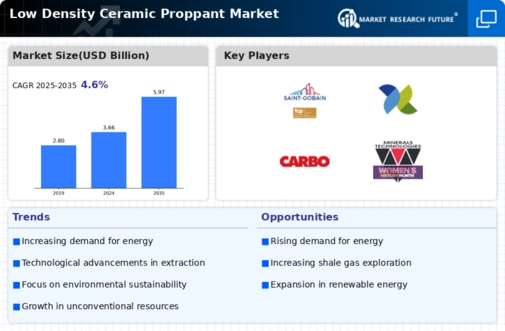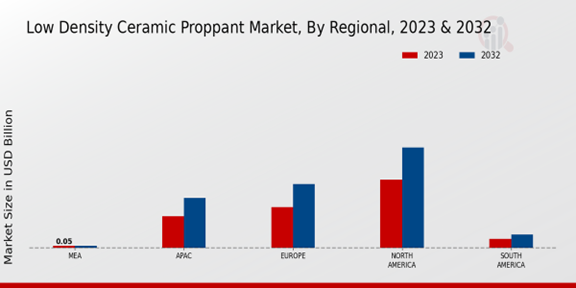Market Growth Projections
The Global Low Density Ceramic Proppant Market Industry is projected to experience substantial growth over the next decade. With an estimated market value of 3.66 USD Billion in 2024, the industry is expected to expand significantly, reaching approximately 5.97 USD Billion by 2035. This growth trajectory suggests a compound annual growth rate (CAGR) of 4.55% from 2025 to 2035. Such projections indicate a robust demand for low density ceramic proppants, driven by factors such as technological advancements, increasing exploration activities, and regulatory support for sustainable practices in the energy sector.
Increasing Demand for Hydraulic Fracturing
The Global Low Density Ceramic Proppant Market Industry experiences a notable surge in demand due to the increasing adoption of hydraulic fracturing techniques in oil and gas extraction. As energy companies seek to enhance production efficiency, the use of low density ceramic proppants becomes essential in maintaining well integrity and optimizing flow rates. This trend is further supported by the projected market value of 3.66 USD Billion in 2024, indicating a robust growth trajectory. The shift towards unconventional resources necessitates advanced proppant solutions, positioning low density ceramic proppants as a critical component in modern extraction methodologies.
Regulatory Support for Energy Sector Innovations
Regulatory frameworks that support innovations in the energy sector play a pivotal role in shaping the Global Low Density Ceramic Proppant Market Industry. Governments worldwide are implementing policies that encourage the use of advanced technologies in oil and gas extraction, including hydraulic fracturing. Such regulations often promote sustainable practices and the efficient use of resources, which in turn drives the demand for high-performance proppants. As these supportive measures continue to evolve, they are likely to enhance the market landscape, facilitating growth and the adoption of low density ceramic proppants across various regions.
Growing Exploration Activities in Emerging Markets
The Global Low Density Ceramic Proppant Market Industry is significantly influenced by the growing exploration activities in emerging markets. Countries with untapped oil and gas reserves are increasingly investing in hydraulic fracturing technologies, thereby creating a demand for efficient proppants. This trend is particularly evident in regions such as South America and parts of Asia, where exploration efforts are intensifying. The expansion of these markets not only boosts the consumption of low density ceramic proppants but also fosters competition among manufacturers, potentially leading to innovations and improved product offerings in the coming years.
Technological Advancements in Proppant Manufacturing
Technological innovations in the manufacturing processes of proppants significantly influence the Global Low Density Ceramic Proppant Market Industry. Enhanced production techniques lead to the development of proppants with superior strength and lower density, which are crucial for effective hydraulic fracturing. These advancements not only improve the performance of proppants but also reduce costs, making them more accessible to a broader range of operators. As the industry evolves, the integration of advanced materials and processes is likely to drive market growth, contributing to the anticipated increase in market value to 5.97 USD Billion by 2035.
Rising Environmental Concerns and Sustainable Practices
The Global Low Density Ceramic Proppant Market Industry is increasingly impacted by rising environmental concerns, prompting a shift towards sustainable practices in the oil and gas sector. Companies are now prioritizing eco-friendly proppant solutions that minimize environmental footprints while maintaining operational efficiency. This shift is likely to drive innovation in the development of low density ceramic proppants that align with sustainability goals. As the industry adapts to these changing dynamics, the market is expected to witness a steady growth rate, with a projected CAGR of 4.55% from 2025 to 2035, reflecting the ongoing commitment to environmentally responsible practices.















